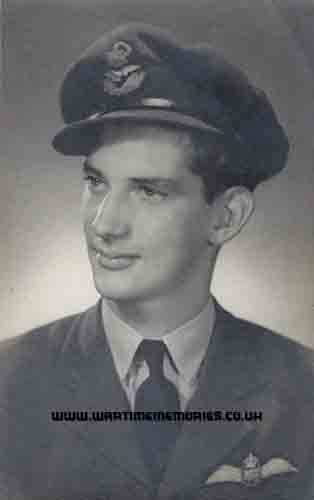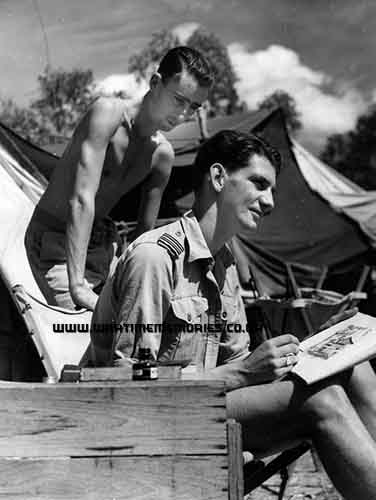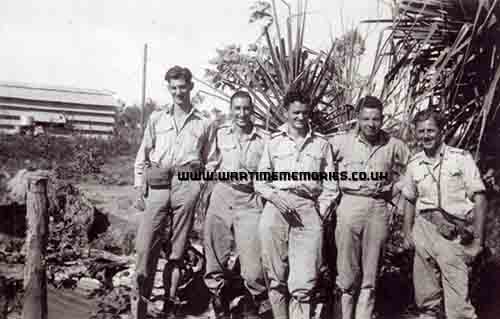Vivian Joseph "Smoky" Hibbens 234 Sqd.
My father, Vivian Joseph Hibbens - became known as 'Smoky' during his time in Stalag VIIIB, Stalag Luft III and Stalag 344. He was an RAAF Spitfire Pilot RAAF No: 400712.
I am writing his story in the hope that someone out there may have some more information on him.
He was born on 16th January 1922 in Bemboka NSW Australia - and his love affair with flying began when he went on a joy flight with Sir Charles Kingsford Smith during his barn storming days around country Australia in the 1930's.
He enlisted in the RAAF in Melbourne on 13th October 1940, and was trained under the Empire Air Training Scheme, doing his Elementary Flying Training at Narromine NSW. He was then shipped to Canada along with other successful trainees and gained his Wings at Camp Borden Ontario in September 1941. This was not without incident - along with a close friend and fellow trainee, Andy Fotheringham (an American from New Jersey who had enlisted in the RAAF in Australia around the same time. Andy was killed in action 4th January 1944), they took a plane each and 'beat up' a little town called Barrie, just north of Niagara Falls. Seeing as though they flew between the Post Office and a Hotel just above car height at 160 mph - they received quite lenient sentences. Andy was found guilty of one charge and received 21 days detention and my father was found guilty of four charges and received 62 days detention - reduced to 31. Apparently their Commanding Officer went into bat for them - being an old Airman himself from WWI, he 'understood' their folly. My father was housed very well during this time, being given every convenience - even a type writer and open leave to go wherever he liked - as long as he discreetly returned within a reasonable hour. He even went with the Service Police at night into the town to break up brawls and bring the drunken airman and 'prisoners' back to camp.
After he gained his Wings in September 1941 he was shipped to England and was based initially in the South and then at Hawarden in Wales near Chester from where he flew Spitfires with the 234 Squadron. He then applied to go to the Middle East and in April 1942 he was shipped to the Egypt where he flew various missions until one fateful day in July 1942.
He was ferrying a Hurricane back to his base when he ran into a sand storm. When he emerged he was . . . "attacked by 11 Messerschmidt 100F's and I played with them for about 10 minutes until I finally ran out of ammo. I tried too make a run for it but had to put down out of juice and landed smack in the centre of a German Panzer Unit". He was taken captive on the 18th July 1942.
He was taken to Stalag VIIIB where he remained until sometime in late 1943 when he was moved to Stalag Luft III. During his early days in Stalag VIIIB he and the other prisoners' hands were tied up each day, all day. He talks of the boredom, but eventually he was made camp Librarian and he was overjoyed that he then had something to fill the hours. He made 10 unsuccessful attempts to escape by exchanging ID's and going out on working parties, hiding in garbage and linen trucks and digging tunnels. Shortly after the 'Great Escape' from Stalag Luft III he was sent back to Stalag VIIIB - by this time known as Stalag 344. I am not sure what his involvement was with this escape attempt - if any - although he wrote a couple of letters home to his mother dated the 25th and 26th March 1944 stating that he 'would be home soon'! I do wonder if he had written them earlier but post dated them in order to throw the Germans off the track.
During his time in the prison camps he became known as 'Smoky' - due largely to his bartering for food using cigarettes. >From letters received by others - it appears that he was very popular with all and well known for his positive outlook. At one time he was almost mistakenly 'repatriated' to England as he was carrying another man's ID - something he did quite often. At one time he was Pte. S. F Weir, Prisoner No: 5239 (Working Camp E701) and at another he was Pte. D. Simpson, Prisoner No: 8033 (Working Camp E600) so he could get out on working parties and attempt to escape.
Like most POW's his letters were full of hope of making it home 'next Christmas' or for your 'next birthday'. Sometimes he got a special message through - one such was "Oh for an hour in the Garden of Roses"! My grandmother said that she then knew he was starving - as the Garden of Roses was the local Cafe in Corowa NSW where they lived.
I am attaching the only photo I have found of his group of POW's - but I am unsure in which Stalag it was taken. My father is the fifth from the top left back row.
In the winter of 1945, as the Russians were advancing - he and his fellow POW's were turned out of their Prison Camp (Stalag 344) and were forced to march on what was to become known as the Lamsdorf Death March. They marched 200 miles in 15 days in the bitter wind and biting snow. There were only 72 Australians among the 50,000 who were forced to march to get beyond the reach of the advancing Russians. There were few German guards, so they patrolled the perimeter with bayoneted guns and dogs. The POW Officers were placed 'in charge' of their own group of men, who were marching in lines of three, tied together. My father was allowing one line at a time to 'disappear' in the hope that no-one would notice. However, eventually a German Guard came to my father and said . . . "more of your men have escaped than any others. I have orders to shoot you if any more disappear . . . I think you know what you have to do"! So he went at the next opportunity. Some of my father's men were found by the Czech Underground and they asked them to go and search for my father. I remember my father telling me (which was a very rare occurrence - as like most he never spoke about his war time experiences) "I was huddled under a bush half asleep and I felt a hand on my shoulder . . . and I thought 'this is it, I'm dead' . . . but it was the Czech Underground". They took him to safety in Kydne where they cared for him and nursed him back to health. He lived with them until the Americans arrived and he went with them into Berlin.
There are several letters from the Czech people that he lived with written after the war. My grandparents 'sponsored' one of the Czech men and his wife to Australia - Joe and Anna. There is also a letter from a German Lance Corporal Ernst Rudek written on 10th July 1947 who was a guard at Stalag VIIIB who got to know my father on the Death March. He speaks of the time they fossicked for food together in the Croatian and American Prisoner of War Camps and bought vegetables for my father's mates, and of a 'Certificate' my father wrote for him at the brickworks at Falkenau when the prisoners were handed over to new guards. He wrote . . . "There were good and bad on both sides - and from my actions at that time, you knew where my sympathies lay". I believe this is the same man that later contacted my father through the war office and whom he flew to Melbourne to meet 25 years later in the late 1960's.
After the war, my grandmother used to hold Ex POW parties. She would shut all the boys in the kitchen with the food and then sit and listen at the keyhole - it was the only way she could learn what really happened during those days as a prisoner of war.
My father was throughout his life a great RSL man, being President of the Richmond RSL for a number of years and then the Secretary-Manager of the Windsor RSL Club. He never failed to march on Anzac Day in Sydney, after marching with his local RSL and in 1970 attended an ex POW Reunion.
Sadly, my beloved father died aged 50 in 1972 from a heart attack. He had his first heart attack when he was only 36 - as a result of his service during the war years.
"Some die during battle for their country - others, at another time and another place - as a result of fighting for our freedom. Their sacrifice is no less great or less honourable".









